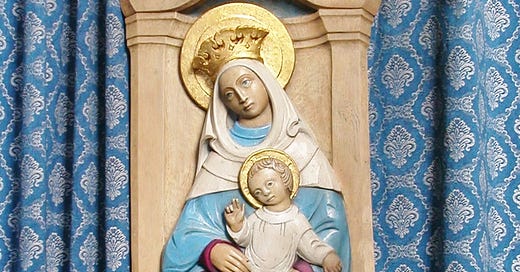To celebrate the feast of the Annunciation I thought i might talk about this from a more personal view point because it was the Annunciation that really opened my eyes to Mary and helped my journey into the Catholic Church.
Mary was a problem to me. Although my Father’s side was Catholic, I grew up with my Mother and her side of the family who were very Presbyterian, DUP voters (Ian Paisley’s party), and although not outwardly sectarian, there was definetly a tinge of that. We participated in the 12th of July, Apprentice boys and some of my relatives were Masons. When I became a Christian I viewed the Catholic Church as heretical, ordinary Catholics conned, mistaken and poorly instructed in their faith. But fast forward 15 years or so from that point and my views on the Church was changing and my ignorance crumbling, but Mary was the final issue. How could she be lifted so high? Queen of Heaven? Idolatry no less, thundered my internal Ulsterman, but one thing niggled me. How does the Unfathomable, Completely Other, Holy God, allow Himself to enter sinful flesh? How does He, who no one can look at - become human flesh? How come He is not born with Sin, through the line of Mary? The answers begin in the Annunciation; ‘Hail Mary - full of Grace’.
The words pronunced by the Angel Gabriel to Mary on that fateful day in cosmic history. That phrase was not a 1st century ‘hey how are you?’ - instead it was a description of an identity, it was a title. This young Jewish woman was not like her friends or family, there was something very different going on in her. We also need to realise that these (and other) Marian elements of the gospels reflect early strands of Christianity and ones that were embraced and carried within the community from those early days in the Upper Room.
When reading Luke’s narrative we see that he was masterfully weaving in the history of Israel into this young woman. The Angel begins the conversation with, ‘rejoice’. This particular phrase in the Greek is found in only 4 places in the Sepaugint OT, and they all have messanic purpose. The passage in Luke though is alluding in particular to the Prophet Zephaniah in Chapter 3:14 of his book. As Pope Emeritus Benedict XVI wrote in Mary: The Church at the Source:
What in the prophecy is said to daugther Zion is now directed to Mary: She is identified with daughter Zion, she is daughter Zion in person. In a parallel manner, Jesus, whom Mary is permitted to bear, is identified with Yahweh, the living God. P65
As he continues in the book he points out that now that she is identified as Daughter Zion, so she is identified with all the Church. Mary is ‘the mirror’ in which the Church is to look.
The phrase full of grace (sometimes translated ‘highly favoured’) is an odd statement because it was said in the past tense and never said again in the rest of the New Testament:
Pope Pius IX connects this uniqueness to Mary’s Immaculate Conception when he explains that this greeting “showed that the Mother of God is the seat of all divine graces and is adorned with all gifts of the Holy Spirit” (Ineffabilis Deus, 1854). In other words, even before the Holy Spirit came upon her and the power of the Most High overshadowed her, she already had “a special grace and privilege of God” from the “first instant of the soul's infusion into the body” (Ineffabilis Deus, 1854). This word “full of grace” (kecharitōmenē) means that “the Blessed Virgin was, through grace, entirely free from every stain of sin, and from all corruption of body, soul and mind; that she was always united with God and joined to him by an eternal covenant” (Ineffabilis Deus, 1854). Scott Hahn, https://www.scotthahn.com/blog/fullofgrace.
When I began to see this my opposition to Mary began to crumble and just how important she is to the Church and God’s plan. It opened my eyes to the other portions of Scripture about her and the Church’s understanding of those truths into the doctrines we know today.
Today, on the Feast of the Annunciation draw near to the mystery of God to which our Mother in faith is always leading and always pointing us. Let us pray:
Ouer Laidy o’ Aiberdeen; Praye for us
Ouer Laidy o’ th’ Isles; Praye for us
Ouer Laidy o’ Pluscarden Praye for us
Haily Mither o Gode, Quein o Scots, Praye for us
A Bànrigh na h-Alba; A Mhàthair naomh Dhè, Guidh air ar son
Our Lady of Pluscarden
Picture by Eileen Clare Grant
By Eric Hanna




